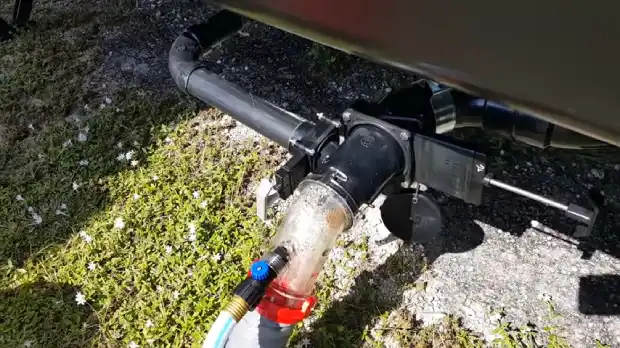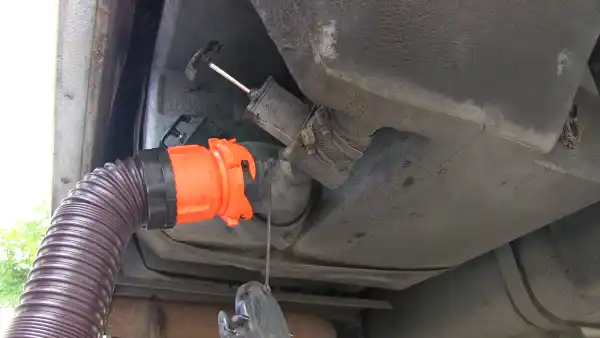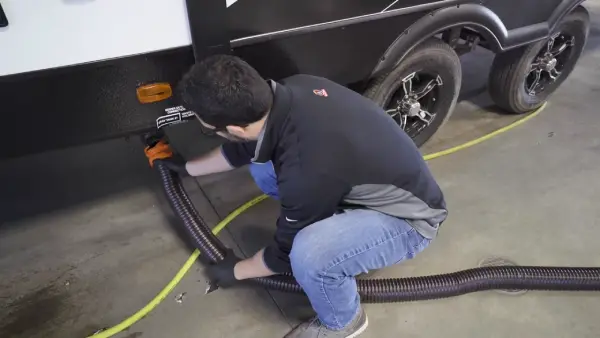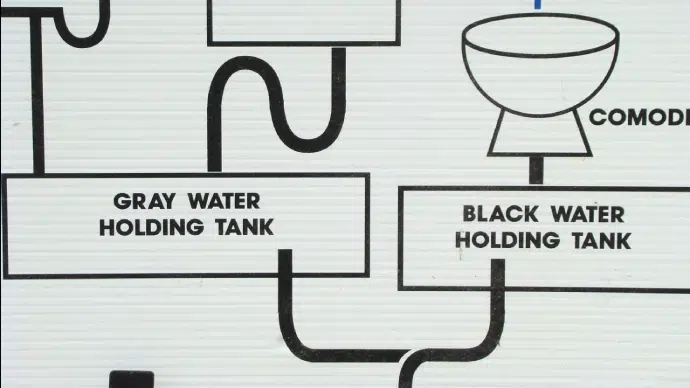Last Updated on September 19, 2023
For avid travelers, RVs are a favorite mode of transportation for exploring new places while enjoying the comfortable living space that comes with them. One of the most important features of an RV is its plumbing system, which many non-RVers may not fully understand.
Specifically, the separate black and grey water tanks are essential components of an RV’s plumbing system. Though this concept may seem strange to some, it serves several important purposes that make life on the road comfortable for travelers.
Separating black and grey waste helps prevent cross-contamination, improving sanitation and protecting the environment. By exploring the details of RV plumbing, we can better appreciate how this separation benefits travelers.
The Reasons Why Do RVs Have Separate Black And Grey Water Tanks

You can get the best of both worlds with an RV – exploration and comfort. But what makes them truly special is their plumbing system: two separate tanks for black water and grey water waste. Here we explore why RVs have separate tanks of black and grey water:
#One: Prevents Cross Contamination
RVs separate gray and black water to prevent cross-contamination. The black water tank, which holds waste from the toilet, contains harmful bacteria that can cause health problems if it mixes with other sources of water.
On the other hand, grey water comes from sinks and showers and typically has fewer harmful pathogens than black water.
However, mixing these two types of wastewater could risk human health. By having separate tanks for each type of wastewater, RV owners can prevent cross-contamination between the two systems.
The separation ensures no contact between untreated sewage and clean water in the vehicle’s plumbing system. Furthermore, keeping them separate makes both tanks easier to maintain as they require different cleaning processes due to varying levels of contaminants present in each.
# Two: Improves Sanitation
In addition to preventing cross-contamination, separating gray and black water tanks helps RVs stay clean. The presence of harmful bacteria in black water necessitates its proper disposal, which is made easier by separating it from greywater.
Moreover, maintaining separate tanks reduces the risk of clogs and backups resulting from mixing different types of waste.
This ensures that the plumbing system remains clean and functional.
Also, properly disposing of human waste prevents unpleasant odors from permeating the RV.
#Three: Protects Environment
Another important reason for having separate black and grey water tanks in RVs is that it helps protect the environment.
By keeping these two types of wastewater apart, individuals can ensure that harmful pathogens from human waste do not contaminate natural bodies of water or soil. The presence of chemicals and other pollutants in greywater also poses a risk to the environment if it is not disposed of properly.
A separate tank allows for more efficient treatment and disposal methods that minimize ecosystem harm.
Furthermore, by properly disposing of both black and grey water, individuals contribute to maintaining clean surroundings while living or traveling in an RV. This promotes responsible stewardship of resources and supports sustainability efforts, which are increasingly essential for preserving our planet’s health.
Why Grey Water is Less Contaminated: Two Reasons

Maintaining a hygienic environment in RVs doesn’t just involve cleaning – separating black and grey wastewater is also part of the equation. So why might grey water be less contaminated than its darker counterpart? Let’s take an exploratory dive into two explanations:
One: Greywater Treatment
Greywater treatment is an important aspect of managing wastewater in RVs. The term ‘grey water’ refers to the unused yet relatively clean and uncontaminated water from sinks or showers in an RV. It does not include toilet waste, which is categorized as black water.
Grey water typically has lower levels of biological contamination than black water, making it less hazardous for humans and the environment. One reason why grey water is less contaminated compared to black water is that it contains fewer pathogens due to its origin.
Unlike black water which originates from toilets containing human feces and urine, grey water only includes soapy residue from washing dishes or bathing. As a result, greywater can be treated with simple filtration methods such as sand filters or activated carbon absorbers before being discharged into the environment.
Two: Greywater Reuse
Greywater reuse systems can significantly reduce water usage in RVs, which is especially important when traveling through areas experiencing drought conditions. In addition to treating greywater for discharge into the environment, there is another option: reuse.
This involves recycling and reusing treated greywater for non-potable purposes such as irrigation or toilet flushing.
The treatment methods used for greywater reuse are more advanced than the ones used for discharge. In these methods, organic matter is broken down in greywater while contaminants such as nitrogen and phosphorus are removed using biological treatments such as constructed wetlands or aerobic bioreactors.
After treatment, disinfection is usually done using chemicals or ultraviolet light to kill any remaining pathogens.
Why is Black Water Can Be Dangerous?
Black water is wastewater that contains human waste and can be a serious health hazard if mishandled. Filled with pathogens, parasites, and chemicals which carry the risk of illness or death. Here are some reasons why black water can be dangerous:
1. Contamination
Contamination is a major concern when dealing with black water tanks because the harmful pathogens that thrive in this environment can lead to serious health risks.
The presence of E.coli, salmonella, and other dangerous microorganisms within black water tanks is a cause for alarm. These bacteria can spread through contact with contaminated surfaces or by inhaling airborne particles from the tank’s contents.
2. Bacteria
In discussing the dangers of black water in RVs, it is important to delve deeper into the topic of bacteria.
As mentioned, bacteria like E.coli and salmonella can thrive in a black water tank if not properly maintained. The microorganisms can cause serious health problems for anyone who comes in contact with contaminated surfaces or airborne particles.
Furthermore, high temperatures and long cleaning intervals can also exacerbate bacterial growth in black water tanks.
This underscores the importance of regular maintenance procedures like flushing the tank with freshwater and adding appropriate chemicals to control odor and bacterial growth. It is also worth noting that proper disposal methods are crucial when dealing with black water waste.
3. Health Risks
RV black water hazards are not limited to environmental hazards. The presence of harmful bacteria in the tank can pose significant health risks for individuals who come into contact with it.
Exposure to contaminated surfaces or airborne particles from the tank’s contents could result in infections caused by pathogens such as E.coli and salmonella.
Various factors, including high temperatures and extended periods between cleanings, can intensify bacterial growth in a black water tank.
Proper disposal methods are also critical when dealing with black water waste to avoid environmental contamination and prevent potential health hazards for others.
RV owners must follow established guidelines for disposing of their wastewater at approved locations such as designated dumping stations. Failure to do so may lead to severe consequences that could endanger human health and harm the environment.
Thus, proper care and attention must be given to managing black water tanks to ensure safety and sanitation while on the road.
What do RVs do with Grey Water?
The need for treatment of black water in RVs is evident. However, why do these vehicles separate black and grey water? The answer lies in their respective waste products.
Grey water originates from shower drains, sinks, and laundry machines. This type of wastewater may contain soap residue, food particles, and chemicals but does not pose as significant a risk as black water. Therefore, separating them into different holding tanks makes sense.
Moreover, having two separate tanks allows for more efficient wastewater management while camping or traveling in an RV. Greywater can be easily disposed of through dumping stations or used for certain purposes, such as watering plants outside the vehicle.
What do RVs do with Black Water?

To handle black water effectively, an RV typically has a specialized sewer hose connected to the tank at one end and to a designated dump station at the other end. To empty the tank, just open the valve on the sewer hose and let all the wastewater flow into the sewage treatment plant or septic tank.
Use only biodegradable toiletries specifically formulated for RVs when flushing. Always dispose of black water at authorized dumping stations instead of regular public toilets.
Do You Leave Black Tanks Open When Emptying Gray Tanks?
When emptying gray tanks, leaving the black tanks open is unnecessary. It is important to note that leaving the black water valve open is not recommended, as waste-eating bacteria don’t function properly. It is advisable to keep the black tank valve closed at all times, except when actively dumping a full tank.
To keep your RV in top condition, close the black tank valve whenever you’re not actively dumping a full tank. Additionally, suppose you’ll be dry camping or boondocking for an extended period. Leaving the gray valve open can cause waste buildup in your sewer hookups, so turn it off.
How Long Can You Wait to Empty Black Tank?
As a general rule, a 40-gallon black tank inside an RV or similar dwelling can be expected to last approximately 10 days before requiring emptying. However, the duration may vary depending on the frequency of toilet paper usage, water consumption, and the number of people utilizing the water systems.
Regular monitoring of your black tank is essential to keep unpleasant odors and blockages at bay. Waiting too long between emptying can seriously impact the comfort of living in a motorhome, so be sure to stay proactive with this important step.
Journey in Comfort and Style: Separate Your Wastewater Tanks.
For RV travelers, the key to a successful and comfortable journey is separating black and grey water. These tanks play a vital role in maintaining sanitation and preventing contamination in an RV. They’re not only safer and more efficient, but they’re also good for the environment.
An RV experience is optimally enjoyable when travelers responsibly dispose of their waste. With separate black and grey water tanks, you can do your part to protect nature’s delicate ecosystem and make for a more comfortable trip overall.
So if you’re planning an RV adventure, make sure you have a separate black and grey water tank.



